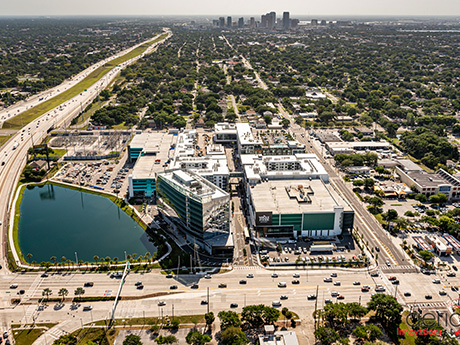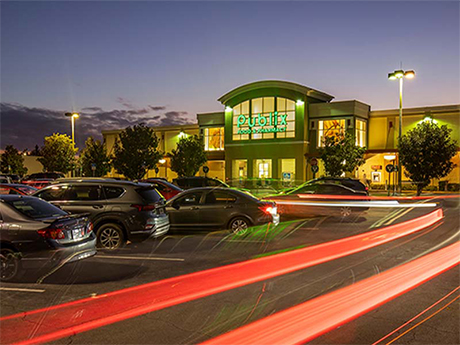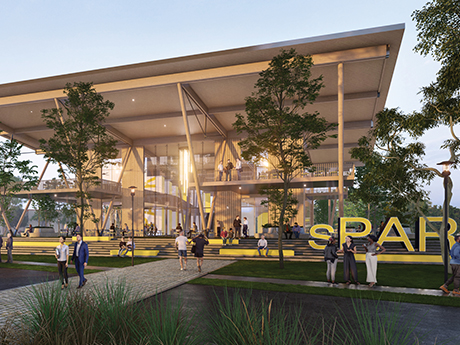Increased interest rates and challenging insurance costs would normally stifle a multifamily market. However, an inventory constrained by a lack of land, supply chain issues, labor shortages and the increased cost of homeownership have contributed to a further stabilization of the metro New Orleans multifamily market. The overall vacancy factor for our seven primary submarkets that make up metro New Orleans are in the 5 to 6 percent range. We anticipate occupancy rates to steadily increase going forward as new construction has stalled and rising interest rates have delayed many tenants from transitioning to homeownership. Overall rental rates in the metro average in the $1,250 to $1,350 per month range. The rents represent a 3.5 percent increase over the past 12 months. It should be noted that some submarkets have seen considerably higher increases. The highest rental rates reported in the metro for garden-style communities are in Eastern St. Tammany Parish, where the newest inventory exists. The highest rents in New Orleans are downtown in the CBD/Warehouse District. These communities comprise mid-rise and high-rise developments and command rents exceeding $2.50 per square foot. The downtown market experienced some softness during the COVID-19 pandemic but made a robust recovery once restrictions …
Southeast Market Reports
New Orleans has seen significant, pent-up retail growth over the past 12 months as we emerge from the COVID-19 pandemic. More recently, however, external forces have provided some headwinds and caused tenants and investors to go back to their corners to reassess. Inflation, rising interest rates, insurance premium increases and elevated construction costs have all contributed to uncertainty in the Greater New Orleans retail landscape. Within the French Quarter and CBD, growing concerns from crime have forced some CEOs to look outside of the city core for their office headquarters. This issue, coupled with the current “work-from-home” environment, causes downtown retailers to rely even more on tourism and convention business. Thankfully, the hospitality sector has had success and is now exceeding pre-pandemic levels. Due to an active 2021 hurricane season that saw Hurricane Ida devastate South Louisiana, insurance rates have skyrocketed as carriers continue to leave the state. As a result, landlords have struggled with how to handle these unforeseen spikes in expenses. Should they pass those on to the tenant or eat them to remain competitive, or a combination of the two? 2022 has been a surprisingly quiet storm season, so with any luck these rates should begin to …
In the post-pandemic environment where employers are trying to navigate new work schedules, office tenants are focusing more on the finish and design of office space than they are the rents. In New Orleans, we are seeing office tenants rethink the concept of office space altogether, and their employees are thinking differently about their individual offices as well. There has been a shift from the traditional office space of years past where one spends eight hours a day in a large private office with the door closed. The office has evolved into more of a social place. Companies want their employees to come back to the office and not to be fully remote. Many employees want to get out of their pajamas and come back to the office. But, getting them all to come back has proven to be the challenge. Companies are now enticing their employees with redesigned spaces that are more aesthetically pleasing and rich with amenities that allow for more social interactions and collaboration. Employees who work remotely a few days a week are coming to the office because they want that engagement with their colleagues. Tenants are now less interested in refurbishing private offices and spend …
Atlanta’s prowess within the Sun Belt as the dominant multifamily market did not happen by accident, nor did it occur overnight. Back in the 2000s, Atlanta was still an emerging market that was working to attract new employers while battling a season of oversupply that hampered rent growth across the city’s numerous submarkets. Now, and since the mid-2010s, Atlanta has defined itself as the premier entry point for investors looking to break into the Sun Belt, and its proven track record ensures it will continue serving as a global magnet for relocation, investment and expansion. Atlanta’s diversified economy has attracted some of the nation’s biggest and best names in just a few years’ time. While Silicon Valley has captured the tech world’s eye for decades, global powerhouses such as Microsoft, Google and Meta (Facebook) have started planting their flags in Atlanta with reported goals of adding tens of thousands of highly paid employees by 2030. Tech companies are capitalizing on a strategic opportunity in Atlanta to broaden their workforce in a market that boasts a highly educated and diverse population while providing an attractive cost of living. With respect to Atlanta’s employment growth, the presence of Georgia Tech cannot go …
What was once a vacant landscape has undergone a modern-day renaissance, transforming into a thriving, energetic hub infused with dynamic retail, local chef-driven eateries and desirable living and working environments. Tampa has evolved into a top “a place to see” and “place to be” for both out-of-state guests and residents alike. What is one the main driving forces behind this urban revitalization? The rise of high-density mixed-use developments and lifestyle centers that create central spaces for people to live, work, play, shop, dine and explore new experiences. Recently, Florida has benefited from a massive influx of residents and development activity as a result of the COVID-19 pandemic. Varying demographics and age groups flocked to the Sunshine State in search of more space, agreeable weather and an expedient reopening as far as retail, restaurant and entertainment. Along with the mass of new residents, Tampa quickly rose to become the second most popular city in the country for prospective homebuyers, reflecting a new interest to settle down in the area. The retail sector also boomed state-wide, but specifically in Tampa, with retail rents growing 7.8 percent over the last 12 months and ranking among the top 10 fastest growing markets, according to …
Following the trends of both regional and national multifamily statistics, the Louisville metro area has had a robust stretch of development, repositioning and innovation in the multifamily housing sector that has surpassed 10 years in duration. With a population of 1.32 million, there are 516,000 households in Louisville with an average household income of $69,000. Pursuant to a recent CoStar Group report, Louisville has a total inventory of just over 84,000 units. It is anticipated that there will be over 91,000 units by 2026, a 8.3 percent increase. CoStar also forecasts that the Derby City’s vacancy rate will hover around 5.5 percent in 2026. One of the projects under development includes The Reserve (the Stable) at English Station. The 172-unit, Class A community adjoins a patio home development that was developed by Sunshine Industries. The property is slated for completion in January 2023. As far as popular neighborhoods for development, there are several recently developed or under construction projects in the city’s East End district. The city’s economy has benefited from the accelerated adoption of e-commerce as a result of the pandemic. Retailers and logistics providers are leasing a record amount of space as they seek to expand their distribution …
Remote Work Prompts Flight to Quality, High Urban Vacancies for Louisville Office Market
by John Nelson
The Louisville office market is taking diverse paths forward following the pandemic. The suburban Class A market is thriving with new construction, rental rate growth and resiliency in the face of downsizing tenants and negative absorption. A flight to quality among tenants has benefited local developers such as NTS Development, which has been constructing first-class, next-generation buildings at ShelbyHurst Office Campus since 2012. NTS recently completed its fifth speculative office building at the project, 425 North Whittington, a four-story, 130,000-square-foot building that is 60 percent leased with strong leasing activity. The flight to quality is driving tenants to choose higher-quality buildings with more expensive rental rates to help attract and retain talent and cater to a hybrid workforce. Traditional downtown occupiers are also considering the suburbs for the first time to create a workplace that draws employees back to the office. Suburban vacancy rates have increased since the end of 2019, with the Class A rate increasing by 490 basis points to 13.5 percent and the Class B vacancy rate increasing by 440 basis points to 15.2 percent as of second-quarter 2022. The average asking rental rate for Class A suburban space rose during this period despite increased vacancy rates. …
With vacancy in Louisville’s industrial bulk market sitting at 1.7 percent, an increase of supply is sorely needed. Fortunately, plenty is on the way. At the halfway point of 2022, over 9.5 million square feet of bulk inventory is under construction, with approximately 4.8 million square feet slated for completion by year-end. Due to the demand for big box distribution warehouse space, which skyrocketed due to COVID-19 and the increase of online ordering and e-commerce fulfillment, absorption (12.9 million square feet) outpaced construction (9.9 million square feet) to the tune of 3 million square feet, and depleted vacancies in the process. Average asking rent increased from $4.79 per square foot to $5.26 in the second quarter and is up 26.7 percent from $4.15 at this time last year. This can mainly be attributed to overall increase in demand and increased construction costs. With nearly 5 million square feet of new speculative product hitting the market by year-end, coupled with recent completions of approximately 3 million square feet and 1.6 million square feet of sublease space expected to hit the market in the near future, deal rates are expected to steady and could potentially decrease as competition among landlords increases over …
The retail market in the Orlando MSA is doing well, on the surface. According to the numbers, the region has recovered from the effects of the COVID-19 pandemic. Orlando’s economy is heavily driven by tourism and when travel stopped and the initial state-wide shutdown orders went into effect on April 3, 2020, the impacts were profound and widespread, since four of the top 10 employers in Central Florida are in hospitality or retail, as well as Orlando International Airport. Since then, life in Central Florida has largely returned to normal. Tourism is back, hotel occupancy is up and people are dining out again. Retail numbers for the second quarter are actually better than in the first quarter of 2019, according to CoStar Group. The availability percentage at the beginning of 2019 was 5.9 percent, compared to 4.7 percent at the end of the second quarter. The average rent is up as well, rising from $21.94 per square foot to $25.52. Consumer habits have changed as e-commerce is still enormously popular, although it’s now more about convenience than mitigating risks. For those who can, working from home has become the preferred mode. As a consequence of the remote work trend, local …
While the Research Triangle Park (RTP) is the heartbeat of all things life sciences in the Southeast, the outlying areas of the Raleigh-Durham market, commonly referred to as the Triangle, haven’t been ignored by expansive growth in the sector. Corporate announcements and expansions in Holly Springs, Sanford, Four Oaks and Hillsborough have been more prevalent in recent years, as well as in the home base of Raleigh. Amgen, a California based company, is constructing a $550 million biomanufacturing facility in Holly Springs, and Becton Dickinson recently selected Four Oaks in Johnston County for its new manufacturing site, with plans to invest approximately $25 million in the development. After many years of focusing on the manufacturing industry, Lee County, approximately 40 miles from Raleigh, is becoming a burgeoning hub for life sciences after the expansions of Pfizer’s 230-acre site. A subsidiary of Abzena chose Sanford following a nationwide search for its 325-job manufacturing facility. Also in Sanford, Astellas Gene Therapies delivered a $109 million facility in the second quarter, its first outside California. It is evident that investors and developers see great opportunity in both the heart of the Triangle’s urban cores and rapidly growing outlying counties. Developers are responding to …











